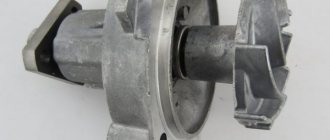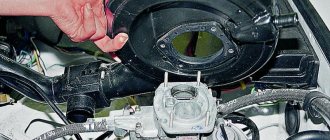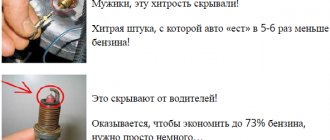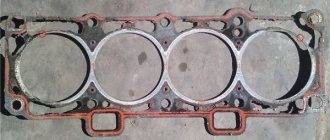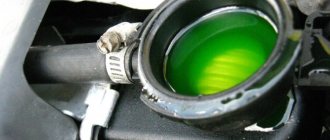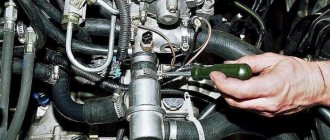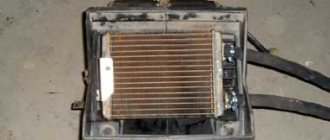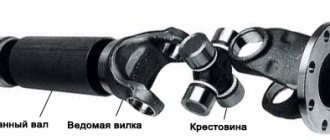The stoves on the Zhiguli “classics” do not differ in special efficiency and most often work according to the principle: there is, and thank God. But they require no less attention than the heaters in other models. And one of the constant reasons to pay attention to the heater in your car is the forced replacement of the heater tap of the VAZ 2107. Moreover, more often the reason for the replacement is not the appearance of traces of antifreeze in the cabin, but the jamming of the heater tap, for example, after a summer of inactivity. Although, by and large, it is absolutely not important for what reason you are changing the heater tap, but what is important is that the replacement is necessary, otherwise the further use of the car will be very problematic.
VAZ 2107 stove valve - purpose, types and replacement
A VAZ 2107 car is equipped with a stove, which is part of the engine cooling system. One of the significant parts of the system is the VAZ 2107 heater valve, which plays the role of regulating the supply of heated liquid to the heater radiator. This element is not reliable enough, so car owners of sevens often encounter problems with it such as jamming and leaking. In case of such breakdowns, it is important to promptly replace the device.
Repair of heating radiator VAZ 2107
A clogged radiator can be flushed with water pressure. Scale on the walls of honeycombs can be removed using a special product that dissolves it.
A leak in a copper (brass) radiator can be soldered. Using a powerful soldering iron and solder, you can repair a hole or crack. Leaking aluminum radiators must be replaced.
Important: to eliminate a leak in the heater radiator or engine cooling system, you should not use products added to antifreeze - they can cause clogging of the VAZ 2107 radiator honeycomb.
Remove severe contamination by washing with cleaning agents. To do this, unscrew the metal tubes from the radiator, after which we fill the heat exchanger with a cleaning agent, give time for the substance to take effect, and then rinse the radiator with running water.
As cleaning agents, use special liquids for cleaning radiators or use traditional methods (citric acid solution).
If flushing does not help and the radiator is blown through with force, only mechanical cleaning can help. But it is not always advisable to do this, since you will have to disassemble the radiator and unsolder it. It is not always possible to put it back together qualitatively.
As for leaks due to cracks, if they appear on the tubes, it is easier to buy new tubes than to repair the breakdown. If the radiator itself is leaking, try to solder the crack (if the radiator is made of brass). Radiators made of brass lend themselves well to soldering, but this work should be entrusted to a professional.
Aluminum radiators cannot be soldered, so if a crack forms, they are replaced.
Before installing the heater radiator in place, evaluate the condition of the foam rubber seal installed in the heater body around the perimeter of the heat exchanger seat. If the seal is in a condition unsuitable for further use, we replace it.
Installing the radiator and assembling the stove is carried out in the reverse order to that described above. In this case, pay special attention to the places where the tubes connect to the radiator - it is better to replace the rubber seals and tighten the fasteners well.
After assembling the stove and connecting it to the cooling system, during the first time the car is used, you need to periodically inspect the pipe connections for leaks.
Purpose and principle of operation of the stove tap
The stove faucet has a simple purpose - switching modes between “summer” and “winter”. In the summer, the heater is not used, so supplying hot water to the heater radiator would make it impossible to stay in the cabin. In winter, hot air in the cabin of the seven arises due to the supply of heated coolant to the heater radiator.
The VAZ 2107 uses two radiators - one is the main one, which is designed to cool the engine, and the second heater is used mainly in cold weather. The heater radiator, which is located in the passenger compartment, also cools the engine slightly when the fan is turned on, while ensuring the flow of warm air into the car interior.
The switch in question has a smooth adjustment from the “closed” position to “fully open”. The valve is located directly inside the VAZ 2107 car on the supply pipeline, and is controlled by a steel cable connected to a mechanical regulator on the instrument panel.
Frequent device malfunctions
Car owners remember the device when malfunctions occur. There are two main malfunctions of the device that require replacement of the switch, as well as additional ones. In the event of additional damage, the integrity of the switch can be restored without the need to replace it. Let's consider the main types of malfunctions of the device in question:
- The occurrence of antifreeze leaks is one of the most popular types of breakdowns on classic Zhiguli models, including the VAZ 2107. A malfunction appears when a puddle of antifreeze begins to appear in the car interior under the driver’s feet. Moreover, to do this, it is not necessary to wait for this puddle to form, because as soon as the faucet begins to leak, a corresponding pungent odor appears in the cabin. If this part leaks, it must be replaced, since it cannot be repaired.
- A jammed heater radiator tap occurs when it is impossible to move the switch. The reason for its jamming is the formation of corrosion processes inside. Corrosion occurs quite quickly, and 5-6 months is enough time for the development of such a process. If a part is jammed, you can open it or, conversely, close it with pliers. In this case, keep in mind that you can collapse the rotary rod or cause a leak. If the device jams, it is also recommended to replace it as quickly as possible.
In addition to the main ones, there are additional types of malfunctions of heating taps on the VAZ 2107:
- A leak forms from under a pipe or clamp. The pipe and clamp are the elements that are connected to the stove tap. With prolonged use of the car, the fastening of the clamp weakens, so a leak begins to form from the pipe. A simple action will help eliminate such damage - tightening the clamp or replacing it.
- Inability to close or open the tap, which is directly related to internal blockage of the device. The reasons for the development of such consequences are known - low-quality antifreeze, contaminants entering the cooling system, as well as corrosive deposits. To eliminate this type of breakdown, it is necessary to remove the part and clean it.
- The drive cable used to open and close the tap is broken. In case of this type of breakdown, you will need to replace the cable and continue operating the car with a working interior heating system.
The part in question has enough signs of failure, so before making serious decisions, diagnostic procedures should be carried out to identify the exact cause of the malfunction.
Types of stove taps
If, from the above situations, your seven has a malfunction that requires replacing the heater tap, then before doing this, you need to figure out the choice of the optimal device. It is difficult to say how long the standard switch on a VAZ 2107 will last, but reviews from owners show that the need to replace it most often arises after 3-5 years of vehicle operation. In order for the replacement device to last longer, you will need a competent approach to its selection. Which heater valve is better to install on the VAZ 2107, we will look into it in detail, analyzing all the options.
Heater ball valve
From the factory, membrane-type devices are installed on the seven, which have a short service life. If you want to increase the service life of the switch, it is recommended to replace the standard diaphragm valve with a ball valve. This option is more reliable compared to a membrane device, since a steel sphere is used in the switch design.
The sphere is connected to a rod, through which the structure is activated. It opens by moving the rod in the form of an elongated handle 90 degrees. The disadvantage of the device is that although the sphere is made of stainless steel, corrosive deposits appear on it. Typically, such devices last 1.5-2 times longer than membrane ones.
Diaphragm type tap
Membrane-type devices are installed on all seven injection and carburetor types. It is not known why manufacturers installed cranes of this type on sevens, but this option is the most unreliable. In the best case scenario, such a part will last no more than 5 years.
Membrane-type devices cost about 300 rubles, and the choice of such a device is justified only in one case, if the owner does not want to spend money and make adjustments to the cooling system of a VAZ 2107 car. Experts recommend installing such valves as a last resort, if nothing more suitable can be found managed.
Ceramic faucet
The best solution for those who do not want to replace standard devices every 2-3 years. To modernize the VAZ 2107 stove, it is recommended to install a heater valve with a ceramic locking element. The advantages of ceramics are obvious - long service life, reliability, efficiency. They have only one drawback - the price, which is 3-4 times higher than membrane switches.
Water tap
If you want to “kill two birds with one stone,” that is, save money and at the same time get a durable tap, then it is recommended to give preference to a water tap with a butterfly or lamb-shaped valve. The cost of such devices is low, and they do not last as long as ceramic ones, but an order of magnitude longer than membrane ones. To install the switch in the system, you will need connecting hoses with clamps. There is only one drawback to using such devices - the need to switch modes manually.
Replacement instructions
Replacing the faucet on a VAZ 2107, as on other cars, requires draining the fluid from the system. To do this, you should initially wait until the liquid has cooled, and then place the container and unscrew the plug, waiting for the system to empty. Further replacement of the VAZ 2107 heater valve is carried out in the following way:
- Under the hood, loosen the clamps of the hoses going into the passenger compartment and remove them.
- Using a “10” key, you need to unscrew the bolts that secure the partition with the pipes going into the cabin.
- After this, move it into the cabin and loosen the cable that is connected to the switch. To separate the cable from the tap, you need to loosen the nut with an open-end wrench set to “10”, and then disconnect the tip.
- Remove the tap from its location by first unscrewing the two fastening nuts. These nuts secure the device to the heater radiator.
- Dismantle the device, and then unscrew the adapter on which the hose is attached. When installing a new tap on the seven, you will need to replace the rubber seals.
The process of assembling the device is performed in the reverse order of removal. If you decide to install a switch with ceramic filling, then no modifications will have to be made. If you are installing a water switch, then you will need to use hoses of a suitable diameter.
The entire replacement process does not take even 2 hours. After replacing the device, antifreeze should be poured into the system and the heater valve should be checked for proper operation. It is recommended to make sure that the mode switch is working properly before the onset of winter or with the arrival of spring.
Stove malfunctions
Due to the simple design, there are not so many faults in the interior heating system of the VAZ-2107. They are divided into mechanical and electrical. Mechanical problems include:
- jamming of the antifreeze supply valve;
- radiator clogged;
- breaks in the drive mechanism cables;
- smudges.
The tap and heater radiator are the “weak” points in the VAZ-2107 stove. If in winter the tap works frequently, then with the onset of summer it turns off and remains in that position. Because of this, it jams, and when winter comes, attempts to open it lead to a break in the control cable.
Video: The heater on the classic VAZ 2101-07 does not work. We are looking for the reason.
It is difficult to “move” a faucet that is stuck in one position, so it is easier to replace the faulty unit. And cutting off the antifreeze supply also affects the radiator. The absence of fluid movement for a long period (when operating a car in the summer, when the stove is not in use) leads to intensive formation of oxides inside the radiator, which clog the heat exchanger pipelines. Because of this, the throughput of the radiator decreases, and with it the performance of the stove.
A clogged heater radiator is washed, but if there are a lot of deposits, then they can only be removed mechanically, and for this the radiator is unsoldered. Soldering it back is difficult and sometimes it is easier to replace the heat exchanger than to wash it.
Leaks are also a common failure. They occur at the junction of the pipes, and also if a crack appears in the radiator. In the first case, the leak is eliminated by tightening the fastening clamps, in the second - by soldering or replacing the radiator.
Electrical faults include burnout of the electric motor, open circuit of its power supply and breakdown of the control key.
What is a VAZ 2107 stove valve?
To heat the interior of the VAZ 2107, the heat of antifreeze circulating in the engine cooling system is used. To extract heat, a heater radiator is used, which is connected to the cooling system by two hoses. The heater fan forces a stream of air through the radiator, which heats up and enters the passenger compartment. However, heated air is not always necessary in the cabin. If you turn on the glass blowing in the summer to prevent them from fogging up when it rains, heating the air will be unnecessary. To prevent air heating, the VAZ 2107 heater valve is included in the heating system circuit, which prevents hot antifreeze from entering the heater radiator. Then the air supplied by the fan does not heat up and the interior is not heated during the warm season.
The valve is secured to the radiator with two bolts, and a rubber gasket is used to seal the connection. The working part of the crane is connected via a rigid control cable to a lever on the front panel of the machine. By moving the lever, you can open and close the tap, regulating the temperature of the air entering the car interior.
Usually in winter the faucet of the VAZ 2107 stove is open, and in summer it is completely closed.
Control mechanism
The control of the VAZ 2107 stove is mechanical. It consists of a fan switch and a block of sliders. The control mechanism is installed on the center console at the top, which provides easy access to the elements.
There are three sliders of the control mechanism, and each of them controls its own element:
- The top one is responsible for supplying antifreeze to the radiator and is connected by a cable to a tap installed on the inlet pipe. The extreme left position of the slider means the tap is closed (the stove does not heat), the right position means the tap is open (antifreeze enters the radiator).
- Middle – air supply damper control. When you move it to the left, the damper shuts off the air supply from the street (closed air circulation in the cabin), while the right position means the air flow is open (air from the street enters the cabin).
- The lower one controls the damper for distributing the flow through the air ducts. Left position - the flow is supplied through the side and central deflectors, right - to the windshield area. Each of these sliders can be adjusted to any position to achieve optimal stove operation.
Malfunctions of the heater valve VAZ 2107
The main cause of malfunction of the heater valve is wear of the seals and gaskets. The result is a drop in the level of antifreeze in the cooling system and overheating of the engine.
An antifreeze leak from the heater tap can be detected by the appearance of drops or puddles in the passenger compartment near the passenger's feet. The leak also manifests itself as condensation of antifreeze on the windows in the form of an oily substance. The latter does not happen if water is poured into the cooling system instead of antifreeze. Then you should pay attention to another sign of a coolant leak - a drop in its level in the expansion tank.
If there is a coolant leak in the area of the heater tap, you should try to tighten the bolts and check the tightness of the fastening. If the leak does not stop, replacement or repair of the VAZ 2107 heater valve is necessary.
Note: Antifreeze contains components that are harmful to health, so leaks must be repaired as quickly as possible.
The faucet of the VAZ 2107 stove may become clogged and stop switching. This malfunction can be eliminated by cleaning or replacing the faucet. It is still impossible to switch the tap when the control cable has been disconnected from it. The problem is easily fixed: the cable must be put in place and secured.
Determining why the heater tap does not switch is simple:
- if the cable falls off, the adjusting lever moves easily without encountering resistance;
- If the faucet is clogged and jammed, the lever begins to move very tightly and jam.
Repairing the VAZ 2107 heater tap consists only of cleaning it in case of clogging. In other cases it needs to be changed.
Here are some tips for the stove tap:
Stove design
Structurally, the heating system of the VAZ-2107 consists of several elements. The main thing is the radiator - coolant circulates through it.
- a casing with dampers and a control mechanism for the latter;
- electric stove fan;
- several air ducts;
- tap.
The design of the system under consideration does not contain electronics or any complex mechanisms, which largely determines its reliability and ease of maintenance.
Heating in the 2107 model occurs due to the circulation of coolant through a large circuit of the system intended for it. Antifreeze flows from the engine through a pipe directly into the heater radiator, located under the dashboard. The intensity of circulation is regulated by a special tap connected by a cable pull to a lever leading into the cabin.
What is needed to replace the heater valve of a VAZ 2107
The replacement operation is quite simple and does not require special tools or equipment. Before starting work, it is necessary to drain the antifreeze from the cooling system, for which you need to prepare a special container. You will also need:
- wrenches 7 and 10;
- crosshead screwdriver;
- pliers;
- new heater valve for VAZ 2107.
It is better to purchase a ceramic faucet rather than a standard one. Its parts do not wear out as intensively, and the surface does not become overgrown with dirt and scale.
Replacing the heater valve VAZ 2107
Before starting replacement, you should wait until the engine has cooled down. Before starting work, it is necessary to drain the antifreeze into a prepared container. Replacing the VAZ 2107 heater valve is carried out as follows:
- disconnect the heater supply pipe, which is located in the engine compartment;
- remove the heater air duct located on the right under the front panel;
- unscrew the control cable casing and disconnect the latter from the heater tap;
- unscrew the two nuts securing the tap to the heater radiator (when removing the tap, antifreeze may leak, so you need to place a rag or sponge under it);
- remove the heater valve;
- unscrew the adapter onto which the supply pipe is placed;
- replace the rubber gaskets between the tap and the adapter, the tap and the stove;
- screw the adapter to the new tap;
- install the tap in place, tighten the fastening nuts;
- attach the control cable, adjusting it so that the tap opens/closes completely when moving the lever on the front panel;
- install and secure the air duct and cable casing;
- attach the supply pipe to the tap;
- fill the system with antifreeze;
- make sure there are no leaks;
- start and warm up the engine, remove air pockets;
- add antifreeze to the expansion tank to the required level.
The replacement of the VAZ 2107 heater valve has been completed, the “seven” is ready for use.
Procedure for replacing the faucet heater
Replacing the radiator of the VAZ 2114 stove
You should know that replacing the faucet heater must be done when it is cold. the engine will avoid all sorts of troubles caused by heated coolant. It is clear that any manipulation associated with the assembly and disassembly of automobile components must be carried out in a certain sequence. This equally applies to work such as replacing silent blocks and replacing a heater valve.
This tap is removed in the following order:
- after the car is prepared for repair work, it is necessary to gain access to the engine compartment,
- in the engine compartment, use a screwdriver to loosen the clamp securing the supply hose, after which the lower one is removed from the heater tap pipe,
- the hose lever of the ventilation control unit is set by the system to the extreme right position. When this closes the air dampers on the side air ducts,
- the body of the glove box and the storage shelf are removed,
- The nut is loosened securing the right air duct to the body. This is done using a 10mm socket wrench. After this, the air duct is removed from the stud and disconnected from the side instrument panel deflector,
- you should loosen the bolt of the heating tap drive rod using a socket wrench size 7,
- the rod shell under the brackets is released, after which the rod tip is removed from the heater tap of the cabin lever,
- two bolts securing the faucet to the stove are unscrewed. the radiator will need a 10mm spanner. At this stage you will also need to fix the lower cage nut so that it does not fall out of the socket. For these purposes, you can use plasticine,
- Actually, now you have reached the place where the heater tap is located. At this stage it is removed - its pipe is removed from the seal, which is located in the partition of the engine compartment. There is also a rubber one here - the gasket plays the role of a seal at the flange connection between the heater tap and the stove radiator. During removal, some coolant may leak out of the heater core. To collect it you will need rags,
- Unscrew the two bolts securing the faucet to the heater pipe. For this purpose it is used carried out at 10,
- key to remove the pipe. The place where the valve connects the heater (its flange) and the pipe is also sealed with a rubber gasket.
This completes the disassembly work. You should begin installing the faucet heater. This is done in the following sequence:
- removed rubber gaskets must be replaced with sequences,
- in the new ones, the reverse of the above, the tap heater is installed,
- The heater valve control lever moves to the extreme right position,
- it is necessary to fill in the missing amount of coolant,
- After the system has been filled with coolant, you need to check the tightness of the connections with the tap between the heater and the heater radiator, as well as when. If necessary, the parts should be tightened with a hose,
- Further assembly of all parts is carried out in reverse.
Sequence note that these works, as well as valve adjustment, can be done by you yourself or with the help of Replacement specialists.
We independently change the heating valve on a VAZ 2107
In our country, driving a car with a faulty heater in winter is strictly not recommended. This rule is true for all cars, and the VAZ 2107 is no exception. The fact is that the heater of this car has never been reliable and has always caused car owners a lot of trouble. And the heater valve, which began to leak literally a year after buying the car, gained especially notoriety among owners of “Sevens”. Fortunately, you can replace this part yourself. Let's figure out how to do this.
Purpose and principle of operation of the heater tap on the VAZ 2107
In short, the purpose of the stove tap is to give the driver the opportunity to switch between “summer” and “winter” modes of heating the interior. To understand what we are talking about, you need to understand how the heating system of the “seven” works.
So, the VAZ 2107 engine is cooled by antifreeze circulating in the so-called jacket. Antifreeze passes through the jacket, picks up heat from the engine and heats up to a boil. This boiling liquid must be cooled somehow. To do this, antifreeze is directed through a system of special pipes from the jacket to the main radiator, which is continuously blown by a massive fan.
Passing through the main radiator, the antifreeze cools and goes back into the engine for the next cooling cycle. The radiator (which in the early “sevens” was made exclusively of copper) becomes very hot after antifreeze passes through. And the fan, which continuously blows on this radiator, creates a powerful flow of hot air. In cold weather, this air is directed into the cabin.
In addition to the main radiator, the “seven” has a small heating radiator. It is on this that the heating tap is installed.
In winter, this tap is constantly open, so that hot antifreeze from the main radiator goes to the stove radiator, heating it too. The small radiator has its own small fan, which supplies heated air directly into the car’s interior through special air lines.
In summer there is no need to heat the interior, so the driver closes the heating tap. This makes it possible to use a heating fan without heating the interior (for example, for ventilation, or when the windows are fogged up). That is, a heating tap is necessary to quickly switch between small and large antifreeze circulation circles in the “seven” heating system.
The stove has lost efficiency - reasons
If the failure of one of the elements of the heating system is not difficult to diagnose, then it is often not easy to deal with cases of loss of efficiency on your own.
So, when the stove produces too little heat at maximum, then it is possible to suspect the following problems:
- blockage of the main or furnace radiator;
- wear of the air intake damper seal;
- cooling system malfunction.
We recommend starting your search for the problem with the heater radiator. For this:
- start the engine;
- warm it up to operating parameters;
- set the oven regulator to maximum;
- feel the radiator, as well as the pipes connected to the tap.
If the latter are both hot, then the heat exchanger is most likely clogged and will have to be cleaned or replaced. When the hoses are cold, there is a problem with the cooling system. Heating of only the pipe leading to the tap indicates that the latter is jammed or the traction cable is broken.
An abnormally high radiator temperature coupled with low heater efficiency indicates airflow problems. This is where the damper gasket most often fails.
Common fuel valve malfunctions
All malfunctions of the fuel valve on the VAZ 2107 are in one way or another related to a violation of the tightness of this device. Let's list them:
- The fuel valve started leaking. It’s impossible not to notice: a large puddle of antifreeze forms under the feet of the passenger sitting in the front seat, and a characteristic chemical smell spreads throughout the car’s interior. As a rule, a leak occurs due to the fact that the membrane in the fuel tap has become completely unusable. This is usually observed after two to three years of operation of the crane;
- The fuel valve is stuck. It's simple: the diaphragm fuel valve mentioned above is susceptible to oxidation and corrosion. Almost all drivers in our country close this tap in the warm season. That is, at least three months a year the tap remains in the closed position. And these three months are quite enough for the rotary rod in the faucet to oxidize and become firmly “stuck” to the body of the device. Sometimes it is possible to turn such a rod only with the help of pliers;
- antifreeze leaking from under the clamps. On some “sevens” (these are, as a rule, the latest models), the valve is attached to the pipes with steel clamps. These clamps weaken over time and begin to leak. And this is perhaps the most minor problem with the fuel tap that a car enthusiast may encounter. To solve it, simply tighten the leaking clamp with a flat screwdriver;
- The faucet does not open or close completely. The problem is due to internal contamination of the device. It is no secret that the quality of antifreeze on the domestic market of fuels and lubricants leaves much to be desired. In addition, counterfeit coolant is also found (as a rule, antifreeze from well-known brands is counterfeited). If the driver is used to saving on antifreeze, then gradually the fuel tap becomes clogged with dirt and various chemical impurities, which are present in abundance in low-quality antifreeze. These impurities form hard lumps that do not allow the driver to turn the valve stem all the way and completely close (or open) it. In addition, low-quality antifreeze can cause rapid corrosion of the internal parts of the standard "seven" diaphragm valve, and this can also prevent the fuel valve from being tightly closed. The solution to the problem is obvious: firstly, remove and thoroughly rinse the clogged tap, and secondly, use only high-quality coolant.
Types of fuel taps
Since the fuel tap on the VAZ 2107 is an extremely short-lived device, after two years of operation of the tap the driver will inevitably face the question of replacing it. However, fuel taps vary in both reliability and design. Therefore, it is worth understanding them in more detail.
Diaphragm type tap
A membrane-type valve was installed on all “sevens” that ever came off the assembly line. It is very easy to find this crane for sale: it is available in almost every spare parts store. This part is inexpensive - only 300 rubles or so.
But the car owner should not be tempted by the low cost of a membrane tap, since it is very unreliable. And literally in two or three years the driver will again see coolant leaks in the cabin. Therefore, you should set the diaphragm fuel valve to “seven” only in one case: if the car enthusiast has not found anything more suitable.
Fuel ball valve
A ball fuel valve is a more acceptable option for installation on a VAZ 2107. Due to its design features, a ball valve is much more reliable than a diaphragm valve. The shut-off element in ball valves is a steel sphere with a small through hole in the middle. This sphere is attached to a long rod. And this entire structure is built into a steel body, equipped with two pipe threads. To open the tap, it is enough to turn its stem 90°.
With all the advantages, the ball valve has one significant drawback, which makes many drivers refuse to buy it. The sphere in the tap is steel. And although faucet manufacturers claim that these spheres are made only of stainless steel, practice shows that in aggressive antifreeze they very easily oxidize and rust. Especially during the long summer downtime, when the tap is not opened for several months. But if the driver is forced to choose between a diaphragm valve and a ball valve, then, of course, he should choose a ball valve. The price of ball valves today starts from 600 rubles.
Faucet with ceramic element
The most reasonable solution when replacing the fuel tap on a VAZ 2107 would be to purchase a ceramic tap. Externally, this device is practically no different from a ball and diaphragm valve. The only difference is in the design of the locking element. It consists of a pair of flat, tightly fitted ceramic plates placed in a special sleeve. This sleeve has a hole for the rod.
When the rod turns, the distance between the plates increases, opening the way for antifreeze. The advantages of a ceramic faucet are obvious: it is reliable and not subject to corrosion. The only drawback of this device is the price, which can hardly be called affordable and starts at 900 rubles. Despite the high price, the driver is strongly recommended to purchase a ceramic faucet. This will allow you to forget about antifreeze leaking into the cabin for a long time.
Water tap
Some drivers, tired of constant problems with the standard “Seven” fuel tap, solve the problem radically. They go not to the auto parts store, but to the plumbing store. And they buy an ordinary water tap there. Usually this is a Chinese ball valve for pipes with a diameter of 15 mm.
Such a faucet costs 200 rubles maximum. After this, the standard diaphragm valve from the “seven” is removed, a hose is passed into the niche where it stood, and a fuel valve is attached to the hose (it is usually secured with steel clamps, purchased at the same plumbing store). This design lasts a surprisingly long time, and in case of corrosion and jamming, the procedure for replacing such a tap takes only 15 minutes. But this solution also has a drawback: the water tap cannot be opened from the cabin. Every time the driver wants to use the heater, he will have to stop the car and climb under the hood.
Speaking about water taps, I can’t help but recall one story that I personally witnessed. A driver I know installed a Chinese crane under his hood. But he categorically did not want to jump out into the cold every time to open it. He solved the problem in the following way: he slightly expanded the niche in which the standard faucet had previously been located using ordinary metal scissors. He drilled a hole on the handle that opens the water tap. He inserted a hook made from an ordinary long knitting needle into this hole. He brought the other end of the spoke into the salon (under the glove compartment). Now, in order to open the tap, he just had to pull the knitting needle. Of course, such a “technical solution” cannot be called elegant. However, the man still solved the main task - not to climb under the hood every time.
see also
Comments 41
How do you like the radiator? Are there any problems with him?
So far everything is fine, no worse than factory. Although, as they say, these are installed at the factory.
I recently bought a radiator for a DaAZ stove, and when I tried to install it in the stove, I learned something new, it turns out that older cars have a narrower stove, which is designed for a copper radiator, while newer cars have a stove designed for an aluminum body, it is wider. I visited all the stores, the sellers were all so happy, I said, if this radiator fits into the stove body, I’ll buy it. everyone had the old type of hull... It was unlucky not for them, not for me. As a result, I went to the disassembly site, they tried on about 10 cases, not one of them fit, in the end the uncle from the disassembly sold me the complete stove from the six assembled for 700. I replaced the copper radiator from it, it became hot. All the same, I need to find a stove body for an aluminum radiator, since I planned to completely remake the stove, I bought a tens of thousands motor with a fan, a Chevy Niva thermostat, silicone hoses. I want to remodel the stove.
Our salespeople are trained in this matter; they immediately ask for a new sample or an old one. That is, the new thick radiator is fatter :)))
But as it turned out, no one knew! They don’t sell anything normal other than luzar, and this is in Siberia. where at minus 40 is this luzar what is and what is not. I bought DAAZ online.
They recommend buying Luzar from us, I thought it might just be a fake. And now I don’t even know... They said that the factory installed DAAZ, if that’s the case, it means that you need to take it. My opinion.
Believe me, many people have wasted their money on the luzar; first of all, it doesn’t heat up. its heat transfer is low, both incoming and outgoing tubes are hot, that is, antifreeze circulates, but the honeycombs are sparse, it does not transfer heat well, and it died quickly, leaking along the joints. I’m going to write another post, I’m saving up photo materials.
Here on Drive, I just saw many people giving laudatory reviews about Luzar pumps. But I won't experiment
